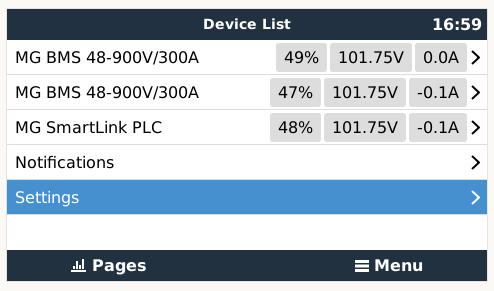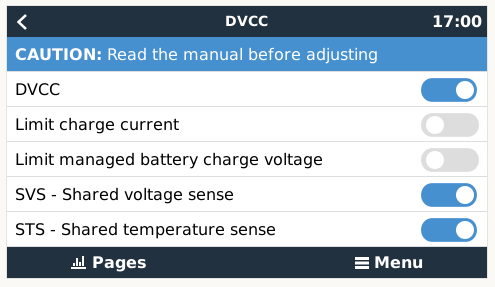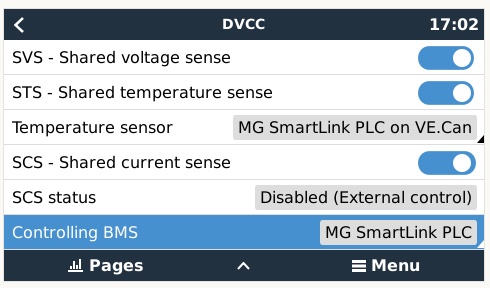¶ Introduction
¶ History
MG Energy Systems (MG) develops and produces advanced battery systems for Marine, Solar/off-grid, industrial and mobile applications. The roots of the cooperation with Victron Energy goes back to 2011 when we developed our first Lithium-Ion battery systems and these were added to Victron’s product range. A development cooperation was setup to achieve maximum compatibility, performance, functionality and safety between our battery systems and Victron’s inverter/chargers. This close development is still an ongoing process. From Master BMS firmware development with new functions to GX products scripts and GUI to extend functionality and compatibility.
¶ Compatibility
The following MG products are fully compatible with (VE.Can) NMEA2000.
- MG Master LV
- MG SmartLink MX / PLC
- MG Master HV
¶ Control solutions
There are two ways to control Victron Energy equipment:
- Direct two wire control
- Digital control through a GX device using DVCC (recommended)
¶ Two wire control
This a control method that uses I/Os to control a charger or inverter. These I/Os are called Allow-to-charge and Allow-to-Discharge. They are both available on the MG Master LV, MG Master HV and MG SmartLink MX.
There are cases that this two wire control is still used for. It can be used for controlling charger or inverters that do not have any communication interface and do not support DVCC. Or when in a larger or redundant system a separate MultiPlus or Quattro needs to be controlled next to a DVCC controlled one.
¶ Digital control
The digital control or DVCC is the recommended way to control the Victron Chargers and Inverters.
Devices that have either VE.CAN, VE.Direct or VE.Bus can be controlled by DVCC. Most of these devices need to have a Victron GX product in between.
One of the exception is the control of the Victron Skylla-I. There is a separate application note available for this device.
¶ Configure digitally control of Victron Energy chargers/inverters
Digital control of Victron Energy chargers/inverters is called Distributed Voltage and Current Control, DVCC. The charge voltage, charge current and discharge voltage and current is controlled by the MG Master BMS. When an MG battery system is almost charged the charge voltage is lowered and that results in a lower charge current. If the MG battery system is fully charged it stops the charging process completely.
When DVCC functionality is used, the
two wire BMS assistantsin the MultiPlus or Quattro devices are not required. If this is configured then it must even be removed to have a proper working system.
¶ STEP 1: Update device firmware
Update all Quattro's/Multi's/Solar MPPT's/GX device and MG Master LV to the latest firmware.
Always update all connected devices to the latest firmware available.
Required minimum firmware versions (can be obtained from the Victron professional
website):
- MultiPlus and Quattro: >422
- GX Device (Cerbo GX, CCGX, Venus GX etc.): >v2.12
- VE.Direct MPPTs: >v1.29
- VE.Can MPPT Solar Chargers: Use the latest.
- Lynx Ion + Shunt: >v2.04
- MG Master LV (Lynx BMS): >v1.09
All components must be digitally connected to the GX device. Either by VE.CAN, VE.Direct or VE.Bus.
Digitally controlled devices:
- Solar MPPT’s needs to be connected by VE.Direct or VE.CAN.
- Quattro’s and Multi’s needs to be connected by VE.Bus.
- Lynx ion BMS or MG Master LV needs to be connected by VE.CAN.
¶ STEP 2: Check MG Master LV settings
In this step the MG Master LV settings are checked.
- Check if the
External CAN bus protocolis set toMG NMEA2000. When this is properly set the name in the GX's device list will begin withMG .... - When a MG SmartLink MX is used, the
Combined battery modemust beEnabled.
¶ STEP 3: Configure GX settings
- Check the Device list if all connected MG devices are online.

- Set the
Battery monitor: Go toMenu->Settings->System setup-> Battery monitor: set toMG Master LV, MG SmartLink MX / PLC or MG Master HV.

- Enable DVCC: Go to
Menu->Settings->DVCC->DVCC: Enable.

- Set the
Controlling BMS(only for GX firmware version 3.00 or higher): Go toMenu->Settings->DVCC->Controlling BMS: set toMG Master LV, MG SmartLink MX / PLC or MG Master HV

The
Controlling BMScan only be selected when it is inRunningmode. This means a MG SmartLink MX must have a MG Master LVRunning(main safety contactor closed).
¶ Configure Two wire BMS control
Coming soon.